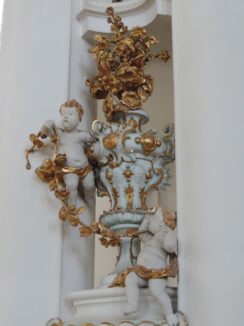The Pilgrimage Church of Wies, or Wieskirche as it is known in German, is a masterpiece of the Bavarian Rococo. The interior holds exquisite detail, and the artisanship is sheer unbelievable. Hold on to your hats, as your minds are likely to be blown on seeing this 18th century gem.
The Wieskirche is, in a way, a good example of deceptive appearances. Bear with me, please, I’ll explain.
Despite being famed for its lavish Rococo interior, it looks like a fairly normal Bavarian church from the outside – albeit more elaborate than you would expect in such a rural setting. I don’t mean offence by this, quite the contrary. I hold this World Heritage Site in high esteem.
The outside is calm and soothing and the combination of the customary Bavarian exterior style, the surrounding meadows and the backdrop of the foothills of the Alps offers extraordinarily pretty views. I imagine this setting would be considered quintessentially German in many places around the globe.
Even though I had seen photos prior to my visit, I was absolutely gobsmacked upon stepping inside. Compared to the soothing “a lovely day out in the countryside feeling” outside, the synapses in my brain went into overkill upon seeing the interior décor. The inside is decked out in incredibly lavish detail, with marble and golden ornaments everywhere and a striking trompe-l’œil ceiling. I just didn’t know where to look first, I just couldn’t take it in.
After taking a few deep breaths, I calmed down and took time to explore. As usual when I visit Rococo churches or palaces, I was torn between two warring emotions. The first is the thought that all this is way over the top. Considering the cost of such buildings and artefacts, it all seems excessive to me. Just imagine how far this money would have gone towards charitable causes. And isn’t it just as worthy to pray in less ornate surroundings? Do worshippers really take more spiritual benefit from attending mass surrounded by fine art and gold? On the other hand, the artisanship truly is amazing and deserves all the praise it can get.
I suppose that my a-religious and more modern viewpoint proves exactly why this is a World Heritage Site: The Pilgrimage Church of Wies is not only an amazing piece of art, it showcases an entirely different outlook on religious worship and European cultural tradition, which was the norm not so very long ago and which is also still relevant to many people today.
The Wieskirche was built on an existing pilgrimage site by Dominikus Zimmermann between 1745 and 1754. Apparently, a countrywoman called Maria Lory had seen tears spilling from a figure of the Flagellation of Christ in 1738 there, which is why this location became a destination for pilgrims. It still is, actually.
The reason that this church was listed as a World Heritage Site by UNESCO is not just the stunning interior, but rather the whole package, so to speak:
“A unique feature is the harmony between art and the countryside. All art forms and techniques used – architecture, sculpture, painting, stucco work, carving, ironwork, etc. – were melded by the architect into a perfect, unified whole, in order to create a diaphanous spatial structure of light and form.”
https://whc.unesco.org/en/list/271
The fact that the church and surroundings remain mostly unchanged also contributes to its special status. Additionally, the official description linked above stresses that “the Pilgrimage Church of Wies is an exceptional testimony of cultural and religious traditions”.
As mentioned before, the area is lovely, and it is very worthwhile to combine a visit of this site with a walk in the countryside.
The Pilgrimage Church of Wies is located in the hamlet of Wies in Steingaden and is accessible by car or public transport. I made the trip from Füssen on a public bus, for instance.
Check the events calendar if you would like to experience special worship services, pilgrim mass or concerts at the Wieskirche. You can find details on the website: https://www.wieskirche.de/en.

 Wieskirche close-up
Wieskirche close-up










